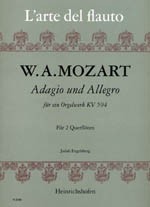No results were found for the filter!

James Hook
6 trios op. 83 | sonatas I -III | volume 1 3 flutes or flute, violin, viola
Hook's role model, Johann Christian Bach, had a long-lasting effect on the English composer's work. He shares with him a strong melodic talent with an emphasised sense of form.
Mehr €29.00 *
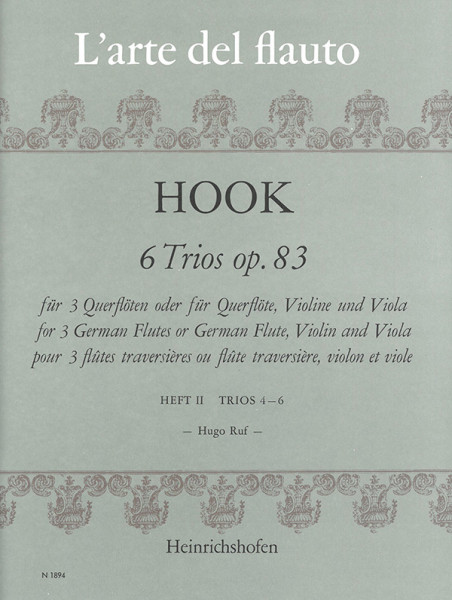
James Hook
6 trios op.83 | sonatas IV - VI | volume 2 3 flutes or flute, violin and viola
Hook's role model, Johann Christian Bach, had a long-lasting effect on the English composer's work. He shares with him a strong melodic talent with an emphasised sense of form.
Mehr €29.00 *
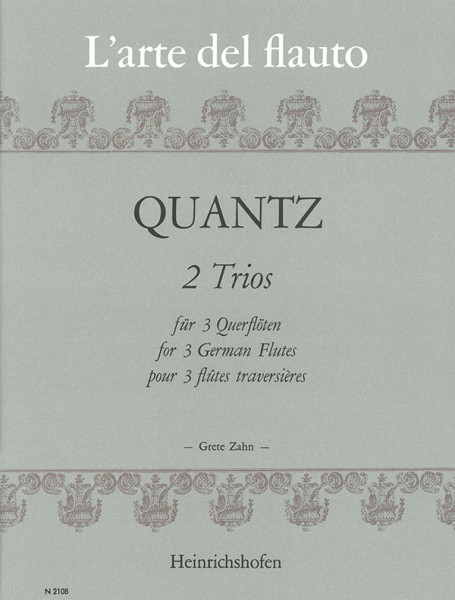
Johann Joachim Quantz
2 trios in D major 3 flutes
Johann Joachim Quantz (1697-1773) was a German composer and flautist. Orphaned at an early age, he was apprenticed to a related town musician in Merseburg. He then studied counterpoint with Zelenka and Fuchs in Vienna in 1717. He joined the Royal Polish Chapel in Dresden and Warsaw in 1718, first as an oboist and then as a flautist. From 1724-1727, he travelled to Italy, Paris and London on an electoral scholarship. Returning to his old position in Dresden, he played for Crown Prince Frederick of Prussia in 1728, who chose him as his teacher and appointed him as his musical confidant in Berlin after his accession to the throne in 1741. Quantz wrote the first German flute school ‘Versuch einer Anweisung die Flöte traversiere zu spielen’, which was authoritative until the 19th century and is particularly valuable to us today as a source for the performance practice of early music. Among other things, he composed flute concertos, chamber music with flute, solo and trio sonatas for flute and basso continuo, flute duets and trios. The present edition is based on the manuscripts of two trios in D major for 3 transverse flutes, which are kept in Det Kongelige Bibliotek in Copenhagen. Additions and embellishments are indicated by small engravings, bracketing and dashes. Content: Trio I - Aria - Rigaudon - Menuet - Sarabande - Plaisanterie Trio II - Adagio - Vivace - Largo - Allegro
Mehr €12.00 *
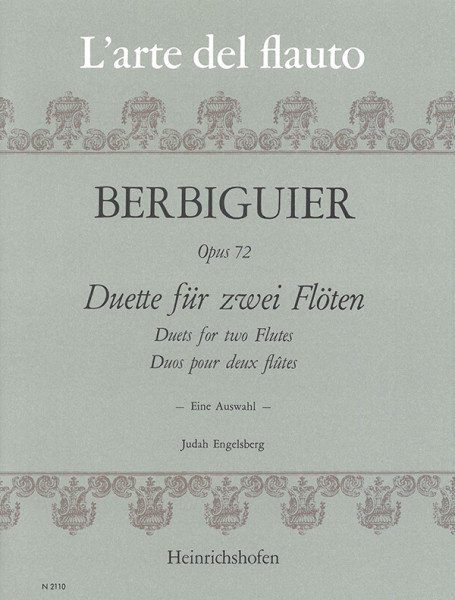
Benoît Tranquille...
Duets for 2 flutes op.72 2 flutes
Benoît Tranquille Berbiguier (1782-1832) received flute lessons from J.G. Wunderlich at the Paris Conservatoire. He himself claimed that he was the first in France to recommend a fully rounded tone in the lower register. Although he never claimed a position with one of the Paris orchestras, Berbiguier enjoyed a reputation as a soloist and important composer. Berbiguier's œuvre includes a MÉTHODE COMPLÈTE POUR la FLÛTE and no fewer than 150 flute duets, a whole series of which were composed especially for use by beginners and pupils. Among them are the 36 Petit Duos op. 72 , of which a selection of the most beautiful pieces are included in this edition. Players will discover the wide range of articulations, dynamics, forms, keys and time signatures in these pieces. At the same time, the quality of the ‘Chantant’ promised in the title is fulfilled. Dotted indications of dynamics and articulation in this edition are suggestions by the editor. Content: 1.Allegro poco vivo 2.Allegro 3.Allegretto 4.Poco Presto 5.Allegro Pastorale 6.Maestoso 7.Allegretto Vilanella 8.Allegro non troppo 9.Tempo di Cosaca 10.Tempo di Valse 11.Fanfare Moderato 12.Andante non tanto 13.Tempo di Marcia 14.Moderato 15.Allegretto 16.Allegro poco vivo 17.Marcia Moderato 18.Moderato 19.Allegro assai 20.Moderato 21.Tempo di Polacca 22.Andante 23.Allegretto 24.Romanza a la Troubadour 25.Allegretto
Mehr €13.90 *
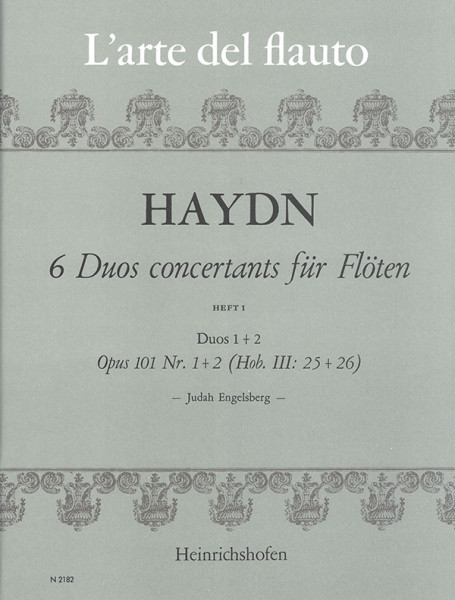
Joseph Haydn
6 duos concertants | Opus 101 No 1 + 2 | volume 1 2 flutes
Content: I. - Moderato - Menuet (Menuetto-Op.101) - Adagio - Presto II. - Moderato - Menuet (poco allegretto) - Adagio - Allegro di molto
Mehr €22.00 *

Joseph Haydn
6 Duos concertants | Opus 101 No 3 + 4 | volume 2 2 flutes
Content: III. - Andante grazioso - Menuet / Allegretto - Adagio - Allegro di molto IV. - Moderato - Menuet / Allegretto - Adagio cantabile - Finale Allegro
Mehr €20.00 *
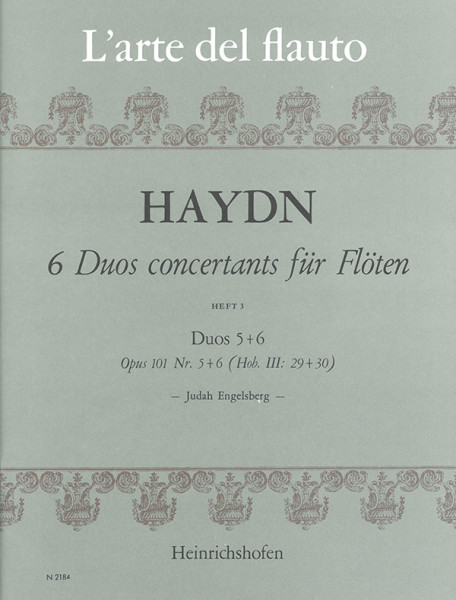
Joseph Haydn
6 Duos concertants | Opus 101 No 5 + 6 | volume 3 2 flutes
Content: V. - Moderato - Menuet / Allegretto - Adagio - Finale Presto VI. - Presto - Menuet - Largo - Finale Allegro
Mehr €16.00 *
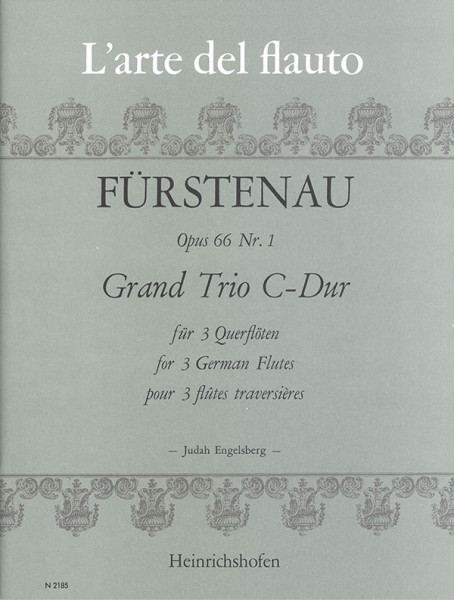
Anton Bernhard Fürstenau
Grand Trio C major op. 66 No 1 3 flutes
Anton Bernhard Fürstenau (1792-1852) belonged to the middle of three generations of flautists and performed in public as a boy of seven. In the years 1803-1818, he accompanied his father and teacher Kaspar Fürstenau on his many concert tours through Germany and Europe. Later he also gave concerts alone or with his son Moritz and enjoyed a high reputation, which, according to contemporary judgement, made him ‘ if not the most excellent, then undisputedly one of the most excellent ... flutists ’. In 1820 Fürstenau moved to Dresden and found a position with the court orchestra conducted by Carl Maria von Weber. A lasting friendship developed between the two artists and when Weber died in London in 1826, Fürstenau was at his deathbed. The musical œuvre of the flute virtuoso can be divided into 3 groups: - works mainly for his own use - didactic works (technical studies, 2 notable flute schools) - chamber music (duets, quartets, quintets, operas with trios for 3 flutes) A thorough study of his compositions and his ideas on music and their realisation on the flute should be worthwhile for every flutist, even today. Content: - Allegro non tanto - Andante - Rondo | Allegretto
Mehr €28.00 *
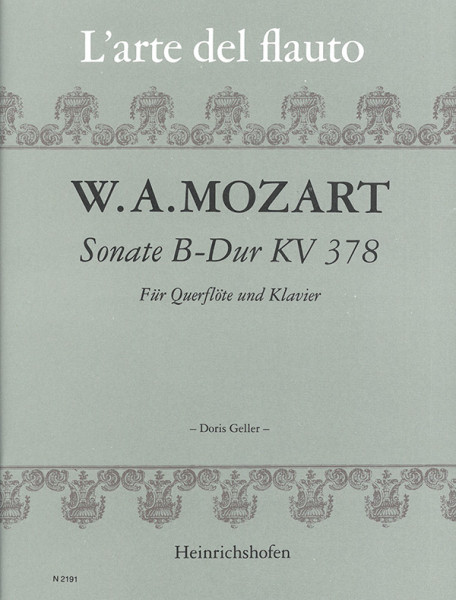
Wolfgang Amadeus Mozart
Sonata B flat Major KV 378 Flutes and piano
Mozart's favourite instrument was not the flute. This is generally known and can be seen from the fact that he only dedicated four chamber music works to it, namely the four quartets for flute, violin, viola and cello. Even the ‘flute sonatas’ - the early sonatas Opus 10, 11, 12 and 13 - which have been available in print for some time, are merely arrangements of sonatas for piano and violin. At that time, the term ‘piano’ meant the harpsichord. It was not until around 1780 that ‘piano’ generally meant the fortepiano. In the manuscript of the Sonata in B flat major K. 378, composed in 1779, Mozart still explicitly specified the harpsichord. It was published in 1781 as part of the second series of 6 sonatas for piano and violin, whereby the order of the instruments mentioned is typical for this period: The piano is the main carrier of the musical action and is accompanied by the melody instrument. Mozart composed 35 sonatas for this instrumentation, but not a single one for flute! In order to give flute players the opportunity to play works by Mozart with piano, this violin sonata was chosen for an arrangement. The work is well suited to the flute, so that no major changes had to be made to adapt the violin part to the technical requirements of the flute. Even the original key (B flat major) could be retained. All the dynamic markings and articulation indications contained in the original text were retained, only the legato slurs in the violin part were altered in some places for the flute. Both dots and wedges as well as intermediate forms indicate the staccato in Mozart. For the facilitate reading, standardised dots have been used in this edition. The dynamic indications in the piano part are not given for each hand individually, as is the case in Mozart's manuscript, but for both hands together, provided they are the same for both hands.This edition enriches the repertoire of flautists with a valuable musical work and brings joy to all players. Content: - Allegro moderato - Andantino sostenuto e cantabile - Rondeau / Allegro
Mehr €22.00 *

Johann Baptist Wendling
6 Duette op. 4 für 2 Querflöten Die vorliegende Ausgabe ist die erste Edition der Wendling-Duette, die in Partiturform erscheint.
Mehr €28.00 *
Viewed


